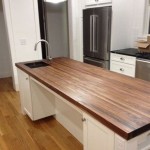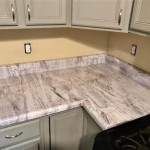How To Upgrade Kitchen Countertops
Kitchen countertops are a central element in any home, serving as both a functional workspace and a visual focal point. Upgrading these countertops can dramatically transform the aesthetic and usability of a kitchen. This article will provide a comprehensive guide on how to approach a kitchen countertop upgrade, covering essential considerations, material choices, installation methods, and maintenance tips.
Assessing Current Countertops and Defining Upgrade Goals
Before embarking on a countertop upgrade, a thorough assessment of the existing countertops is crucial. This involves identifying any existing damage, such as chips, stains, or cracks. Consider the current layout and how it functions. Are the countertops ergonomically suitable for the users, or are there areas where additional workspace or different heights might be beneficial? Evaluate the current countertop material’s performance. Does it withstand daily use effectively, or is it prone to scratching, staining, or heat damage? This assessment informs material selection and design choices for the new countertops.
Defining upgrade goals involves clarifying the desired outcome of the project. Is the primary goal to improve the kitchen's aesthetic appeal, enhance its functionality, or increase the home's value? These goals will impact the budget allocation and the scope of the project. For example, a purely aesthetic upgrade might prioritize high-end materials regardless of cost, while a functionality-focused upgrade might prioritize durability and ease of maintenance. A homeowner aiming to increase resale value may focus on popular, neutral materials that appeal to a broad range of potential buyers.
Budgeting is a critical step. Countertop materials vary significantly in price, ranging from budget-friendly laminate to high-end natural stone. Installation costs also vary depending on the material, complexity of the project, and professional rates. Researching the cost of different materials and installation services provides realistic expectations. It is always advisable to obtain multiple quotes from different contractors to compare pricing and services. Include a contingency fund in the budget to account for unforeseen issues or unexpected costs that may arise during the installation process. Ignoring the budgeting process can lead to significant financial strain and potentially compromise the project's quality.
Exploring Countertop Material Options
The material chosen for new countertops significantly impacts their aesthetics, durability, maintenance requirements, and cost. There are numerous options available, each with unique characteristics.
Granite: Granite is a natural stone prized for its durability and unique patterns. It is resistant to heat, scratches, and stains when properly sealed. However, granite is porous and requires regular sealing to prevent staining from liquids like oil and wine. The cost of granite varies depending on the rarity and complexity of the patterns, with exotic granites commanding higher prices. Granite is a heavy material, requiring robust support structures during installation.
Quartz: Quartz countertops are engineered stone composed of quartz crystals bound together with resin. This manufacturing process allows for a wider range of colors and patterns compared to natural stone. Quartz is non-porous, making it highly resistant to stains and bacteria. It requires minimal maintenance and does not need sealing. While generally heat-resistant, prolonged exposure to high heat can cause damage. Quartz is a durable option that offers a balance of aesthetics and functionality.
Marble: Marble is a luxurious natural stone known for its elegant veining and smooth surface. It is a softer stone than granite, making it more susceptible to scratches and etching from acidic substances like lemon juice and vinegar. Marble requires regular sealing and careful maintenance to preserve its appearance. Its high cost and fragility make it a less practical choice for high-traffic kitchens, but its aesthetic appeal remains undeniable for those willing to invest in its upkeep.
Laminate: Laminate countertops consist of a thin layer of decorative plastic bonded to a particleboard or MDF core. Laminate is the most affordable countertop option, offering a wide range of colors and patterns. It is easy to clean but susceptible to scratches, heat damage, and water damage. Water can seep into the core material if the laminate is chipped or cracked, causing swelling and delamination. Laminate is a suitable option for budget-conscious homeowners who prioritize affordability over durability.
Solid Surface: Solid surface countertops are made from acrylic or polyester resins combined with mineral fillers. They are non-porous and can be seamlessly integrated, eliminating visible seams. Solid surface is resistant to stains and bacteria but can be scratched and damaged by heat. Scratches can often be buffed out, restoring the countertop's appearance. Solid surface offers a versatile and hygienic option for kitchens.
Butcher Block: Butcher block countertops are made from strips of wood glued together to form a solid surface. They provide a warm and natural aesthetic. Butcher block requires regular oiling to prevent drying and cracking. It is susceptible to scratches and water damage, but minor imperfections can often be sanded out. Butcher block provides a functional and aesthetically pleasing surface, but requires consistent maintenance to preserve its condition.
Concrete: Concrete countertops offer a modern and industrial aesthetic. They can be custom-cast to any shape and color. Concrete is porous and requires sealing to prevent staining. It is also prone to cracking, especially if not properly reinforced. Concrete countertops are heavy and require substantial support. They offer a durable and unique option for homeowners seeking a contemporary look.
Installation Methods and Professional Considerations
The installation of kitchen countertops is a critical step that directly impacts their long-term performance and appearance. While some homeowners may choose a DIY approach, professional installation is generally recommended, especially for materials like granite, quartz, and marble, which require specialized tools and expertise.
DIY Installation offers cost savings but requires a high level of skill and precision. The installer must accurately measure and cut the countertop material to fit the kitchen layout, ensuring proper alignment and levelness. Special tools, such as diamond blades for cutting stone and seam setters for joining sections, are essential. Incorrect installation can lead to uneven surfaces, gaps, and structural instability, potentially causing damage to the countertops and surrounding cabinetry. DIY installation is best suited for simpler materials like laminate, where mistakes are less costly and the installation process is more forgiving.
Professional Installation provides assurance of quality and accuracy. Professional installers have the experience, tools, and expertise to handle complex installations involving heavy and delicate materials. They ensure proper support and alignment, create seamless seams, and address any unforeseen issues that may arise during the process. Professional installation typically includes a warranty, providing peace of mind in case of defects or problems with the installation.
Selecting a Contractor requires careful consideration. Obtain multiple quotes from different contractors, comparing pricing, experience, and references. Check the contractor's licensing and insurance to ensure they are qualified and insured to perform the work. Read online reviews and ask for testimonials from previous clients to assess their reputation. A reputable contractor will provide a detailed contract outlining the scope of work, materials used, timeline, and payment schedule. Thorough due diligence in selecting a contractor minimizes the risk of subpar workmanship and potential complications during the installation process.
Template Creation is a critical step performed by professionals to ensure accurate countertop fabrication. The contractor creates a physical or digital template of the existing countertops, taking precise measurements of the cabinet layout, sink placement, and any other features that need to be incorporated into the new countertops. This template serves as a blueprint for the countertop fabricator, ensuring a precise fit and minimizing the need for on-site adjustments. Accurate template creation is essential for achieving a seamless and professional-looking installation.
Support Structure is crucial for ensuring the stability and longevity of the countertops. Granite, quartz, and concrete countertops are heavy and require adequate support from the base cabinets. The contractor may need to reinforce the existing cabinets or add additional support structures to accommodate the weight of the new countertops. Proper support prevents sagging, cracking, and other structural issues that can compromise the integrity of the countertops. Neglecting the support structure can lead to costly repairs and premature failure of the countertop installation.

Update Your Countertops Without Replacing Them

Diy Kitchen Makeover On A Budget Before And After Painted Countertops Tutorial Update

Diy Kitchen Countertop Makeover

20 Ideas For Kitchen Counter Updates Extra Space Storage

How To Remove Laminate Kitchen Countertops

Change The Color Of Laminate Countertops Without Replacing Them

Kitchen Countertop Renovation 5 Best Ways To Redo Countertops

How To Refinish Your Kitchen Counter Tops For Only 30

100 Update Ugly Granite Countertop W Contact Paper Paint Or Epoxy You Ll Want To See This

20 Ideas For Kitchen Counter Updates Extra Space Storage








